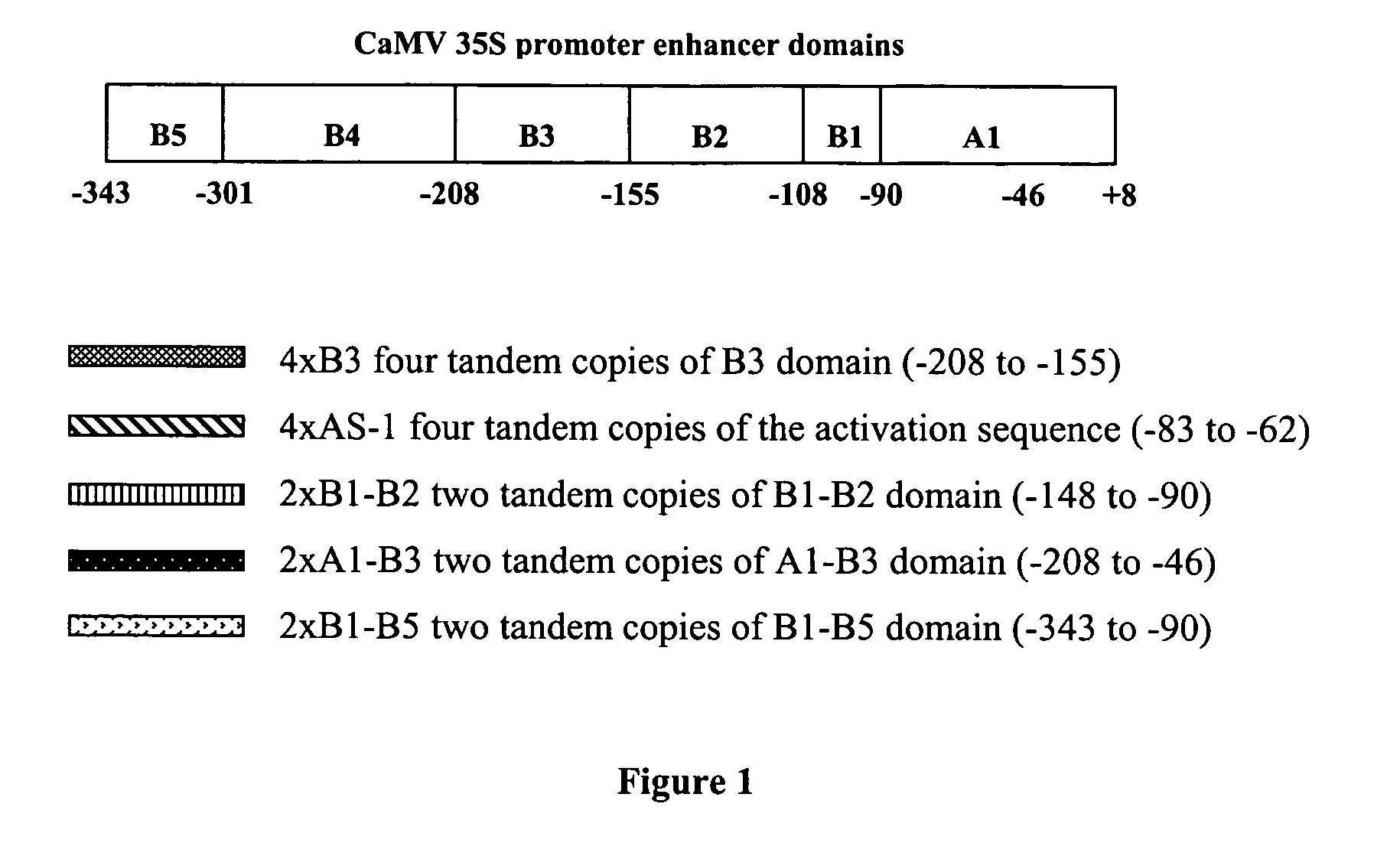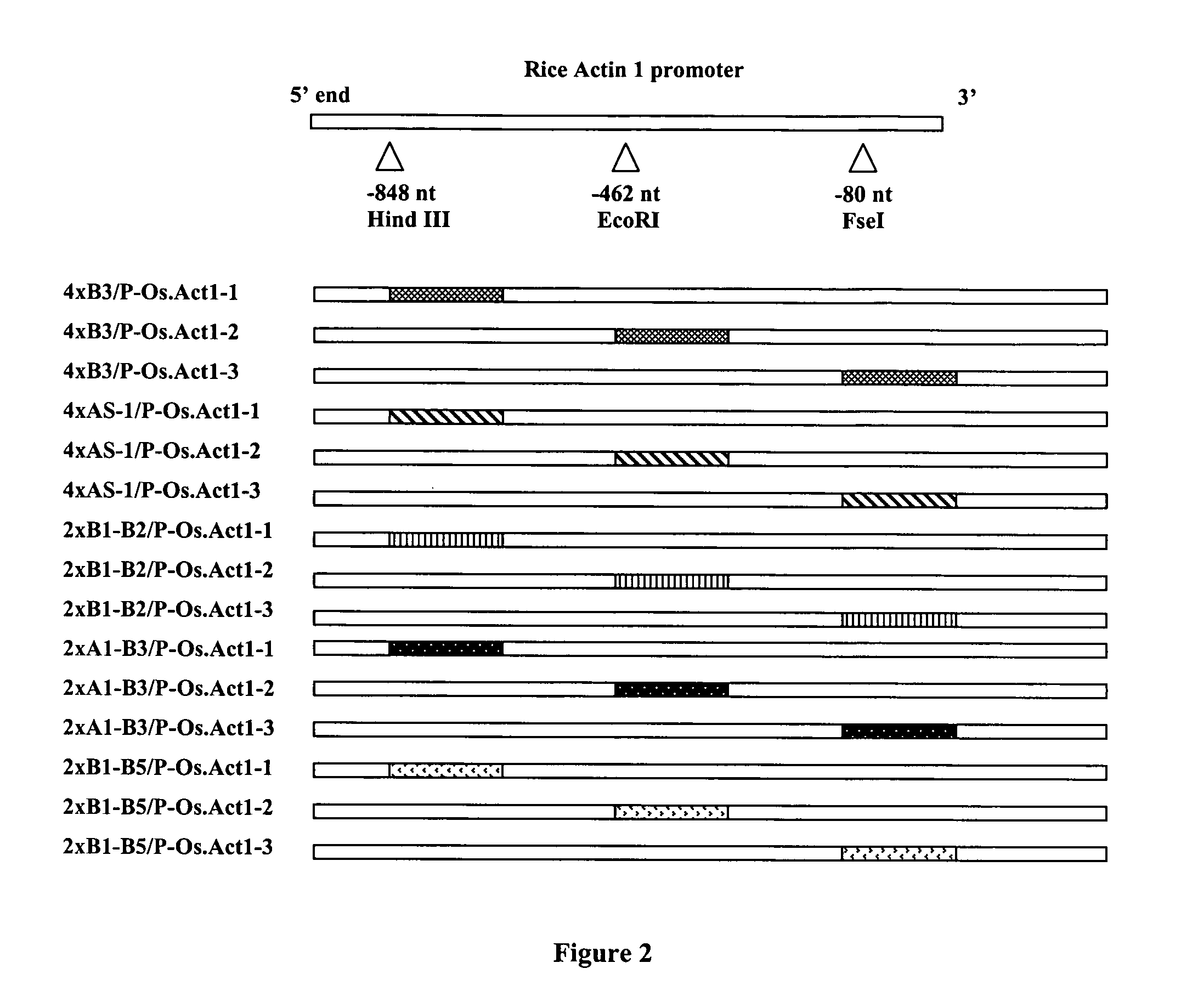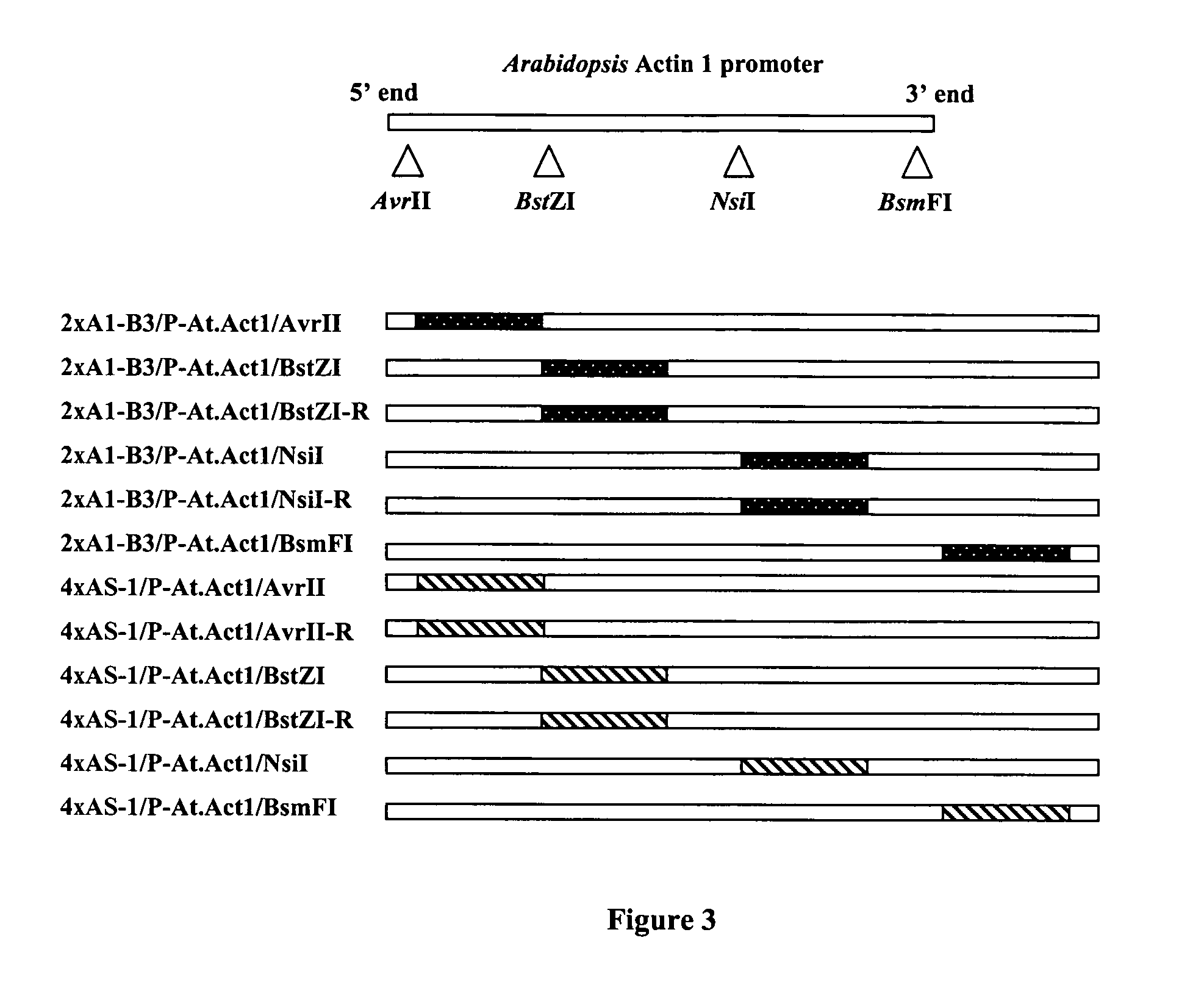Chimeric promoters comprising a caulimovirus promoter enhancer for use in plants
a technology of caulimovirus and promoter, which is applied in the field of plant molecular biology and plant genetic engineering, and polynucleotide molecules, to achieve the effects of inhibiting the growth of weeds, and modulating gene expression in plants
- Summary
- Abstract
- Description
- Claims
- Application Information
AI Technical Summary
Benefits of technology
Problems solved by technology
Method used
Image
Examples
example 1
Construction of Chimeric Promoters
[0045]Novel chimeric promoters are constructed by fusing at least one enhancer domain from a Caulimovirus promoter with a plant actin gene promoter. A brief description of the sequences to herein is provided in Table 1 below.
[0046]
TABLE 1Brief Listing of the SEQ ID NOSEQID NOSequence NameBrief Description1P-CaMV.35S35S promoter sequence from the Cauliflower mosaic virus24xB3P-CaMV.35S Enhancer Domain -- four tandem copies of the B3 domain (−208to −155) as described in U.S. Pat. No. 5,097,02534xAS-1P-CaMV.35S Enhancer Domain -- four tandem copies of the “activationsequence” (−83 to −62) as described in U.S. Pat. No. 5,097,02542xB1-B2P-CaMV.35S Enhancer Domain -- two tandem copies of the B1-B2 domain (−148to −90) as described in U.S. Pat. No. 5,097,02552xA1-B3P-CaMV.35S Enhancer Domain -- two tandem copies of the A1-B3 domain (−208to −46) as described in U.S. Pat. No. 5,097,02562xB1-B5P-CaMV.35S Enhancer Domain -- two tandem copies of the B1-B5 domain...
example 2
Promoter Characterization in Transient Systems
[0059]Selected chimeric promoters were used for transient transformation for reporter expression analysis. Transient systems used included tobacco protoplasts, corn protoplasts, wheat ovary, wheat anther, and barley microspores. Cells were harvested and protein extracted for GUS activity analysis. Methods for measuring GUS activity are well known to those skilled in the art, see for instance Using the Gus Gene as a Reporter of Gene Expression (1992) edited by Sean R. Gallagher, Academic Press, Inc., San Diego.
Monocot Analysis
[0060]Constructs containing chimeric P-Os.Act1 promoters were used to transform corn protoplasts and assay for GUS / LUX activity relative to the P-Os.Act1 promoter and the P-CaMV.e35S promoter. Data are provided in Table 2.
[0061]
TABLE 2Transient Analysis in Corn ProtoplastsChimeric PromoterSEQ ID NOConstructRelative activityP-Os.Act17pMON254551.0P-2xB1-B5 / P-Os.Act1-121pMON383031.6P-2xB1-B5 / P-Os.Act1-222pMON383041.1P-2...
example 3
Characterization of Chimeric Promoters in Transgenic Corn Plants
[0068]Selected chimeric promoters were used for stable corn plant transformation for reporter expression analysis. Plants were transformed using agrobacterium-mediated methods.
[0069]In order to have a direct side-by-side comparison of GUS activity in the cytoplasm and CP4 expression in plastids, and to minimize variations in sampling and environmental factors, a few selected chimeric promoter constructs were built. Each test construct comprised the test promoter driving the GUS reporter gene (beta-glucuronidase coding sequence from E. coli) and the test promoter driving the CP4 gene (bacterial strain CP4 aroA gene encoding class II EPSPS enzyme) in a linear array. Four test constructs, pMON46172 (P-2×A1-B3 / P-Os.Act1-3, SEQ ID NO: 20); pMON46173 (P-4×AS-1 / P-Os.Act1-3, SEQ ID NO: 14); pMON46174 (P-4×B3 / P-Os.Act1-2, SEQ ID NO: 10); and pMON46175 (P-2×A1-B3 / P-Os.Act1-1, SEQ ID NO: 18), and the reference construct, pMON46170...
PUM
| Property | Measurement | Unit |
|---|---|---|
| nucleic acid sequence | aaaaa | aaaaa |
| affinities | aaaaa | aaaaa |
| electrophoresis mobility- | aaaaa | aaaaa |
Abstract
Description
Claims
Application Information
 Login to View More
Login to View More - R&D
- Intellectual Property
- Life Sciences
- Materials
- Tech Scout
- Unparalleled Data Quality
- Higher Quality Content
- 60% Fewer Hallucinations
Browse by: Latest US Patents, China's latest patents, Technical Efficacy Thesaurus, Application Domain, Technology Topic, Popular Technical Reports.
© 2025 PatSnap. All rights reserved.Legal|Privacy policy|Modern Slavery Act Transparency Statement|Sitemap|About US| Contact US: help@patsnap.com



